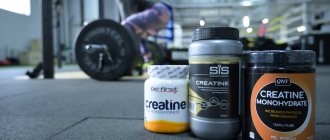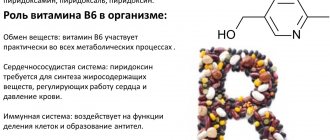Return to blog
18.12.2014
https://youtu.be/zGKxLCmgtM4
Narrated by: Kirill Kolyaskin and Alexey Koshelev
In this video we will talk about this type of sports nutrition as creatine monohydrate, namely: - what creatine is and why it is needed in the human body - the need for creatine in athletes and the norm of creatine in people who do not engage in sports - creatine in food - the effect of creatine on gaining muscle mass - increasing endurance and strength when taking creatine - recovery rate when taking creatine - the effectiveness of creatine for men and women - beneficial effects of creatine - side effects, the effect of creatine on the body - the limit of creatine absorption in athletes per day - dosages creatine per kg of athlete's weight - water retention from creatine - personal experience of taking creatine and reviews from Kirill Kolyaskin - how to drink creatin - release forms of creatine in capsules, powder - method of application with loading, secrets of professionals - duration of taking creatine
- To increase strength
- For gaining muscle mass
- To increase endurance
- To improve muscle definition (due to the hydration effect)
- To increase the secretion of hormones that promote muscle growth (somatropin and testosterone)
- To speed up recovery after workouts
- To reduce the production and effects of lactic acid on muscles
A standard serving at one time is 5g of pure creatine monohydrate powder. If you have lost your measuring scoop from the jar, you can use a teaspoon. One heaped teaspoon is approximately 5 grams. Creatine is best taken with juice (usually grape or apple juice), gainer (note that some gainers initially contain creatine), protein, sugar or complex amino acids for better absorption. Creatine does not dissolve well in cold water, so some athletes prefer not to stir it, but simply drink a teaspoon of powder.
When taking creatine, it is worth increasing your daily fluid intake (up to 3 liters per day) to maximize the positive effect and avoid dehydration.
The Importance of Creatine for Athletes
Creatine Micronized contains only one component - creatine monohydrate. This is the most accessible and effective form of the substance used in sports to increase the mass of muscle fibers, increase strength and endurance. Creatine Micronized powder particles are very small, which ensures good digestibility.
Creatine is a compound that belongs to organic acids. It is directly involved in energy metabolic processes occurring in muscle fiber cells.
https://youtu.be/4crNuEu2las
An athlete uses a lot of his own creatine during intense training, and to compensate for its deficiency, it is recommended to take special supplements that provide the body with this substance. Thanks to the intake of third-party creatine, the athlete’s endurance significantly increases, he is able to train more intensely and for a long time, which has a positive effect on the increase in muscle mass.
Mechanism of action of creatine
The basic unit of cellular energy in our body is a molecule called adenosine triphosphate (ATP). In order for a cell to use ATP, it must first break it down into several smaller molecules, which are then used again to synthesize ATP. One of these substances is of particular interest to us: adenosine diphosphate (ADP). The more ATP our body's cells can store, and the faster they can recover it after use, the more work can be done. This applies to all organs and systems, including muscle cells. Creatine is an integral component of the ATP regeneration process, so increasing its levels increases the amount of work our muscles can do. Specifically, it accelerates the recovery process by “supplying” a molecule that allows the body to quickly convert ADP into ATP, thereby significantly increasing the functionality of our muscles. However, the disadvantage of this system is the natural reserves of creatine in the body, which are very limited. Once these are depleted, our body begins to use glucose and fatty acids to continue producing ATP. However, when you take a creatine supplement, your total body volume increases significantly, with an average increase of 10-20% in your muscles. This provides our muscle cells with much higher levels of readily available energy, which improves anaerobic endurance, strength, energy, and resistance to fatigue and overwork. But the positive effects of creatine on muscles do not end there.
Who is Dymatize Creatine Micronized for?
This dietary supplement is recommended for use by people involved in weightlifting and bodybuilding professionally or at an amateur level. It is also suitable for athletes for whom it is extremely important to develop good acceleration: football players, basketball players, sprinters, hockey players.
Creatine Micronized does not contain any compounds that can be harmful to health, so the supplement can be taken by simply active people who adhere to the principles of a healthy lifestyle.
Who is creatine good for?
Creatine-based nutritional supplements have been used for three decades now. It all started with a few athletes training with the goal of winning the Olympic Games. Since then, athletes have regularly given creatine a place in their diet. Thanks to it, for example, bodybuilders can perform a much larger amount of work during strength training, due to which they quickly achieve their goal of increasing muscle mass.
All people involved in sports, be they wrestlers, football players, sprinters, etc., can become stronger and more resilient by using creatine monohydrate, the prices of which are not exorbitant.
Admission rules
One teaspoon of the additive is dissolved in a glass of juice or plain clean water.
The powder should be dissolved in liquid immediately before use; there is no need to prepare a portion in advance.
In the first week, the manufacturer advises taking Creatine Micronized four times, the total amount of dry matter should not exceed 20 grams (4 times 5 grams). On the eighth day, the dosage is reduced to 5 grams daily. The supplement should be taken after an intense workout. The course lasts 7-8 weeks, after which it is necessary to stop taking the drug for at least a week.
During the course of treatment, you should drink a sufficient amount of fluid (at least 2 liters) to prevent dehydration of the body.
To avoid buying a counterfeit, you should carefully choose a seller: read the reviews if you plan to purchase the supplement in an online store, or carefully study the packaging when purchasing in a regular sporting goods store.
https://youtu.be/sXhHQ49pjVY
Advantages of creatine monohydrate over other forms
Creatine monohydrate is the simplest and least expensive form of creatine on the market. It has existed for many decades and is the absolute leader, but there are many contenders for this throne. Over the years, manufacturers have modified creatine in various ways to make it more effective. How successful were these experiments? Can anything beat creatine monohydrate? Let's look at the most popular forms.
Creatine ethyl ester
It is creatine monohydrate that has undergone a process called esterification - the addition of acid and alcohol. Was developed in the hope that this would increase its absorption and bioavailability, but research shows that this did not happen. And it's more expensive. It cannot even duplicate, let alone beat, the results of creatine monohydrate. The reason for this is that it is less stable, which causes it to quickly convert into a substance called creatinine, which has no beneficial effect in the body.
Buffered Creatine
It is creatine monohydrate combined with magnesium or baking soda to raise its pH value. In chemistry, pH is a measure of the acidity of a solution. A pH value less than 7 is called "acidic" and a pH greater than 7 is "basic" or "alkaline". The more acidic a substance is, the more it can react with other substances and cause chemical changes. The idea behind buffered creatine is to "protect" it from powerful stomach acids, thereby increasing its absorption into the bloodstream. Unfortunately, research shows that buffered creatine supplementation is no better than monohydrate because the acidity in the stomach is so strong that it is impossible to hide any buffering agent from it. But the good news is that 80 to 100% of creatine passes through our stomach unchanged, so it doesn't need the help of a chemical buffer.
Creatine hydrochloride
It is creatine bound to hydrochloric acid. As always, the goal was to increase the absorption and effectiveness of creatine. In this form, the solubility in water has increased, but, unfortunately, the effectiveness and absorption have not improved.
Magnesium creatine chelate
This is a form of the creatine molecule bound to magnesium. Magnesium plays a role in the substance's metabolism, so combining the two could theoretically increase its effectiveness. But even in this case, studies have shown that magnesium creatine chelate is no more effective than monohydrate.
Creatine malate
Obtained by combining with malic acid. Some research suggests that malic acid can increase cellular energy production, which may work synergistically with creatine to improve performance. So far, no studies have been conducted to compare it with monohydrate.
Creatine nitrate
This form is associated with chemicals called nitrates. Research has shown that creatine nitrate is more soluble in water than monohydrate and nitrates may improve performance, but this form has received little research to date. It is too early to draw any conclusions about this substance.
Micronized Creatine
This is a creatine supplement that has been processed to reduce the particle size of the powder. Most micronized creatine you can buy is creatine monohydrate, and while micronization helps it dissolve better in water, it does not increase the absorption or effectiveness of the substance.
Our bodies "micronize" creatine during digestion, breaking it down into smaller particles, so "pre-micronization" doesn't accomplish much other than making it easier to drink.
Creatine pyruvate
This form of creatine supplement is associated with pyruvic acid. Research suggests that this substance may result in a greater increase in plasma creatine levels than monohydrate, but this does not result in increased muscle absorption or effectiveness. As a result, there is a slight increase in its amount, which does not cause a significant effect.
Creatine citrate
Another form of creatine supplement is related to citric acid. Its story is very similar to all previous ones: creatine citrate is more soluble than monohydrate, but no better in terms of end results.
Liquid creatine
It is a form of creatine monohydrate suspended in water. It was intended more as a marketing gimmick than anything else, and studies show that it is much less effective than regular monohydrate. The problem is that creatine, when mixed with liquid, begins to turn into creatinine, which, as you know, does not provide any of the benefits of creatine. So, by the time the liquid creatine product gets into your hands, it is no longer a creatine supplement, but creatinine . But this does not mean that the creatine you mix a few hours before training loses its effectiveness. It takes several weeks for creatine in a water solution to turn into creatinine, so feel free to mix it with water a few hours before taking it.
Possible results
When receiving a quality product manufactured by Dymatize, you can achieve the following results:
- fast, stable gain of muscle mass;
- the ability to increase working weight during training for weightlifters;
- the ability to train more intensively by providing the body with additional energy and increasing endurance;
- improvement of muscle definition;
- faster recovery of the body by providing it with energy after physical activity;
- reduction of injuries during intense physical activity.
Scientific studies have shown that the use of creatine monohydrate is completely safe for health. This substance does not decompose in the stomach and reaches the muscles almost unchanged.
It should also be noted that many manufacturers today offer supplements containing creatine in other forms (not monohydrate), marketing them as more effective for gaining muscle mass. However, scientists refute these manufacturers' statements and claim that monohydrate is the most useful and optimal form of creatine.
Creatine
For a productive workout, muscles need not only protein, but also improved energy supply. Creatine monohydrate is the main supplement for this very improvement with a huge evidence base. Our creatine is also micronized: its particles do not exceed 200 mesh or 0.076 mm in size. Thanks to this, it mixes better, does not precipitate and does not injure the esophagus, relieving stomach problems.
Creatine monohydrate is a sports nutrition that forms the basis of any strength training. The effectiveness of this form of creatine has been proven not only by practice, but also by science. This supplement is the most researched element of sports nutrition according to the international non-profit organization examine.com.
Creatine is the main source of energy for muscles when performing strength training. The main effect of taking creatine is an increase in the volume of creatine depot in the muscles. Thanks to this, taking creatine in recommended dosages helps increase strength indicators from 12 to 20%. Subsequent intake and proper training can further stimulate the growth of strength indicators in the future.
also effective for gaining muscle mass due to its hydration effect. Thanks to this, the muscles not only become stronger, but also look fuller.
How to take creatine?
Research shows that there is virtually no difference between using a creatine loading phase (taking 5-10 grams 4-5 times a day for 2-3 days followed by a monthly dose of 5 grams per day for a month) or just consume 5 grams daily. Therefore, the dosage regimen is your choice. We recommend the standard: one or two scoops (5-10 grams) with water, juice or other favorite drinks.
Protein and creatine are the best combination for making a shake. Along with glucose and expensive amino acids, whey protein improves the absorption of creatine and does not contain sugar.
Creatine is great for women too. You can read more about this in the translation of Lyle MacDonald's article from his Women's Book.
Side effects of creatine? Creatine and kidneys, creatine for women
Creatine is used not only in sports nutrition, but also in medicine. A two-year study from the University of Munich found that taking creatine had no effect on kidney health.
Serving Size: 1 scoop (5 grams) Creatine per serving: 4800-5000 mg (depending on flavor) Servings per jar: 50 (250 grams)
Ingredients: creatine monohydrate, flavor identical to natural, sucralose, citric acid, natural beetroot coloring, anthocyanin.
Shelf life: 18 months.
Certificate of state registration: RU.77.99.32.007.E.005220.11.18 dated November 26, 2018 STO 0082210144-002-2017
How does creatine act on the body?
The substance that gives muscles energy enters them through the blood. ATP is the body's source of explosive energy. Thanks to the conversion of creatine into creatine phosphate, which replenishes ATP reserves, during physical activity our body constantly has access to resources to perform work. Although the process described looks complicated, it all happens within us in a matter of seconds.
What happens when the body does not have enough creatine phosphate? Then ATP appears due to glycogen taken from the liver. This is a kind of reserve. It is thanks to this mechanism that we do not fall alive from lack of strength, even when we feel very tired. Unlike pure creatine, glycogen takes an order of magnitude longer to convert into ATP.
Side effects
For years, the media has portrayed creatine as a dangerous and “obscure” supplement that can have negative health effects when taken long-term. Unfortunately, they came to these conclusions due to a lack of information.
Some of the most common accusations against creatine include dehydration, injury, digestive upset, and even kidney and liver damage. However, to date there are no controlled studies to prove this.
The only clinically identified side effect of creatine is weight gain (due to increased water concentration within cells), which is typically the goal of those who take it.
We can say that man began to consume creatine since he began to eat meat, and this happened, according to scientists, more than 1 million years ago. The research of the substance itself began more than 40 years ago, when it began to be used experimentally to treat heart diseases and improve heart function after a heart attack.
At the same time, unconfirmed information probably appeared that creatine can lead to stomach upset when taken in excessively large doses (20+ grams). However, taking the supplement with enough water or switching to higher quality brands will usually eliminate this side effect.
Side effects
In general, Creatine Monohydrate will not cause problems to the body if taken in small doses in accordance with the planned training schedule. The main rule to remember is that taking large amounts of creatine will not bring much effect. This conclusion can be drawn based on studies according to which excess creatine phosphate content is simply eliminated from the body.
In addition, while taking creatine, it is important to drink a lot of water, as it is able to attract interstitial fluid into muscle cells. Also, science has not fully studied the effect of food supplements with creatine on the body of adolescents. Therefore, if you are under 18 years old, then you should refrain from using creatine for some time.
What do the athletes say?
Most people are satisfied with the results that Creatine Monohydrate gives. Reviews only confirm this. Here are some of them.
One 27-year-old woman was advised to take creatine to gain muscle mass because she was too thin. According to her, she regularly visited the gym, but the results could not be called impressive - the exercises were difficult for her, and there was no increase in muscle mass. Soon she began taking creatine, which made working out in the gym much easier for her, but there was no significant weight gain.
The 24-year-old bodybuilder says he took creatine, the price of which was quite high. He bought products from different companies and, according to him, he practically did not notice the difference between them. But the result was pleasing - a significant increase in muscle mass and a clearer outline of the figure.
One amateur bodybuilder, 32 years old, who recently started taking creatine, claims that he has not yet noticed much effect. In addition, in the first days some problems with digestion began, but then everything calmed down.
One experienced runner also had his own opinion about creatine. He is involved in athletics and constantly participates in long-distance races. The athlete began taking creatine after several difficult races. According to him, he felt overtrained and decided to try Creatine Monohydrate. He didn’t really know how to take it, but one of his friends suggested that he should make cocktails and drink it after training. What was the outcome? Now, as before, he gets a lot of joy from running, since his strength has been restored and energy has appeared.
One young woman who works as a fitness instructor bought flavored creatine, but did not have time to feel the effect. It turned out that she was allergic to it. Then she was told to buy the drug without filler.
As you can see, there are different reviews regarding the use of Creatine Monohydrate. Most strength athletes simply cannot imagine their training process without this nutritional supplement. Why are security forces most dependent on creatine? The loads that such athletes have to endure can be truly extreme. At the same time, the high load on the muscles sometimes continues for 1.5-2 hours in a row while the training is in progress. That is why representatives of strength sports are trying to purchase the best creatine monohydrate. But how do you know which is better?
Beneficial features
Creatine is one of the most widely researched supplements. More than 7,000 scientific articles are devoted to this topic. Hundreds of studies have proven the beneficial properties of creatine monohydrate, including:
- Increasing muscle creatine levels
- Increased performance and improved training performance
- Muscle growth
Below are detailed explanations of these properties.
Increased muscle cretin levels
In order to experience the benefits of creatine, you must replenish creatine stores in your skeletal muscles. According to recent studies, supplementation increases muscle creatine levels by 10-40%.
These results were observed after the so-called creatine loading. It involves taking the substance at a rate of approximately 0.3 g per 1 kg of body weight per day for 5-7 days and 3-5 g per day after the end of this period.
However, the practice of creatine cycling has not been shown to be very effective in maintaining elevated levels of this substance in the body.
Increased strength and performance
Creatine is currently considered the most effective legal supplement for improving anaerobic endurance and increasing lean body mass. About 70% of studies showed a significant increase in exercise capacity in people taking this substance.
In both the short and long term, creatine improves overall training performance, resulting in 5-15% increases in strength and performance. According to the results of almost all studies, proper consumption of supplements increases body weight by about 1-2 kg in the first week of creatine loading.
As the authoritative journal International Society of Sports Nutrition states, “The vast body of positive research on creatine suggests that it is the most effective supplement for building muscle mass and improving performance in high-intensity exercise.”
What is “micronized” creatine?
This is a nutritional supplement consisting of the same substance - creatine. The only difference is the particle size of the powder mass. Micronized creatine has grains that are about 20 times smaller than usual! Why is micronization necessary?
Mainly for better solubility. Anyone who used regular powder noticed that a small sediment of some particles appeared at the bottom of the glass. This is creatine that simply has not dissolved. Because of this, it does not enter the body, but remains in the glass. Therefore, experts recommend buying micronized creatine monohydrate, the prices of which are slightly higher than regular powder.











